A Season in the Heartland

A moving truck backs up to the entrance of the visitors’ locker room at CenturyLink Field in Seattle on Dec. 10, the night the Vikings’ season might have died. Sad containers of uneaten Chinese takeout line a nearby table. Workers toss lumpy equipment bags onto the truck. Everyone can hear the Seahawks whooping in triumph down the hall.
If the wins and the losses, the lucky breaks and the gutting injuries of Minnesota’s 2018 season have come to resemble heart palpitations on an EKG—up and down, up and down again—then this, it seems, is the moment when the heart stops beating altogether. This is what the end looks like. It looks like star wideout Adam Thielen limping off into the night with a bag of ice wrapped around his right ankle; running back Dalvin Cook, finally healthy after missing five games, explaining to reporters, Of course we want to win; jerseys stained with blood and sweat, piled atop a laundry cart; tins of chicken broth and unwrapped sandwiches piled on a fold-up table, untouched. It looks like the franchise quarterback searching for answers about how to jump-start an offense that has been stalled for over a month.
The end looks like embattled offensive coordinator John DeFilippo—a new arrival in 2018, hired away from Philly—emerging last from the locker room, face reddened, laptop open, hoping to salvage what’s left of a mediocre season in which the Vikings still, somehow, have control over their postseason fate. And then... who knows?
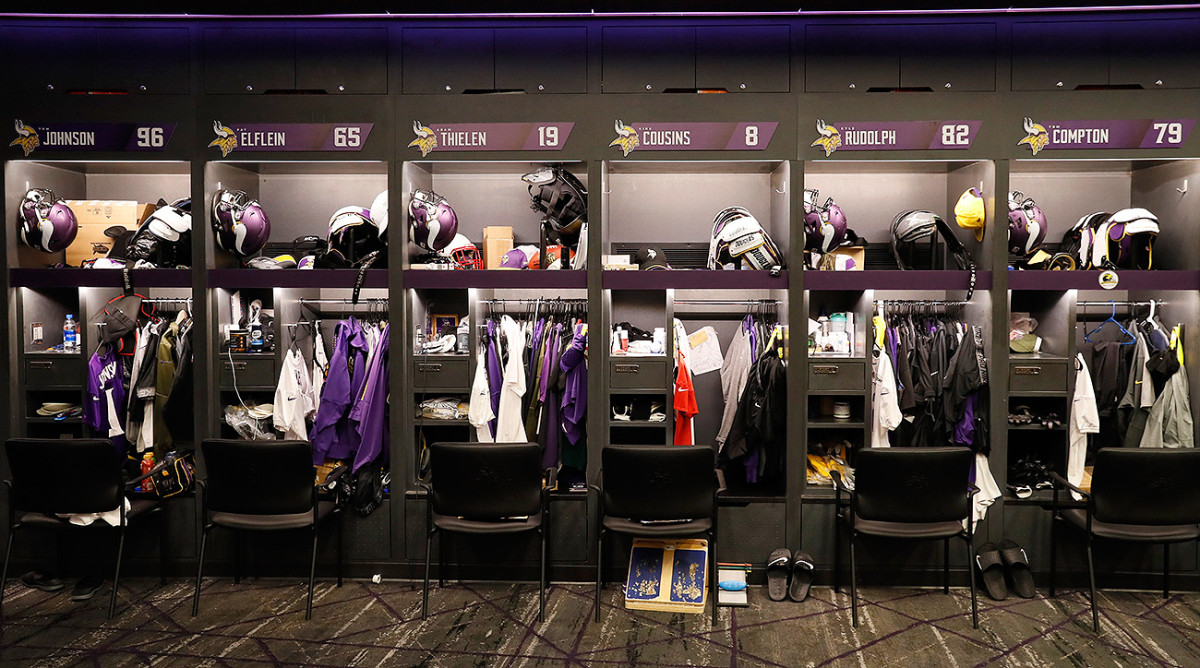
This is the beginning, with all of its hope.
Four months earlier, newly-signed quarterback Kirk Cousins slings passes to Stefon Diggs, who’s just agreed to a five-year extension, with $40 million guaranteed. Thielen assesses the scene and describes the best vibe he’s seen in his five seasons. Tight end Kyle Rudolph points out: He stayed here in Eagan, Minn., all spring, rather than return home to California, because the team had just moved into its extravagant new headquarters, which had everything he needed—massage and acupuncture treatments, cherry juice and grilled vegetables, a sand pit.
Here at the TCO Performance Center, punts no longer doink off the practice facility roof. The hot tub accommodates more than five players at a time. There’s an underwater treadmill ... and a nutrition bar ... These are all stops on the tour given by general manager/cicerone Rick Spielman. Signs all around him extoll the virtues of watermelon water; defensive end Everson Griffen walks by, shouting about how much he loves the turmeric shots at the juice bar.
Coach Mike Zimmer tolerates these new digs, even if some of the more lavish touches make him squirm. He never allows anyone to turn on the fireplace in the locker room, for instance, or to put anything other than the day’s schedule on the dozens of TVs scattered throughout the facility. “Players win games,” the 62-year-old says one day in Eagan, scoffing at the amenities. Asked about the new draft room, with its 40 bigscreens all stitched together, everything digitized, he says: “Seven-hundred fifty-thousand [dollars], just so we don’t have to use f------ magnets.”
Later, Spielman settles into his desk as a summer storm rattles the tables outside on his veranda. Repeat: He has a veranda. Plus a coach he loves (begrudgingly, at times), a top-tier defense, two star receivers and, finally, a franchise QB. “All we have to do now,” he says, leaning back, “is win.”
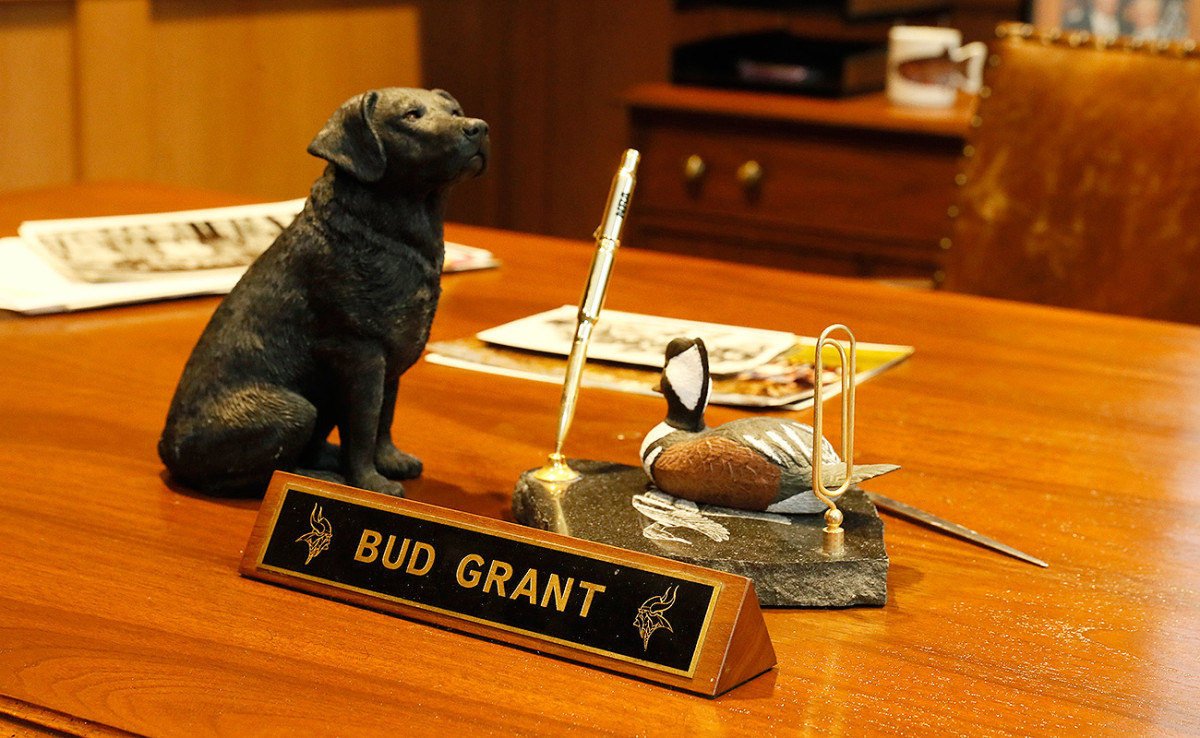
At 91, Bud Grant knows something about winning. The 168 victories he accumulated as the Vikings’ coach from 1967 to ‘85 rank 17th on the NFL’s alltime list. Minnesota gave him an office at the new headquarters, outfitting his space to resemble his cubicle from the old days, replete with a duck phone and a wall-mounted ceramic fish. Today Grant is hosting 98-year-old sportswriter Sid Hartman. They’re trying to explain the Vikings’ complicated history, bickering through it in the way that old friends do. There’s the ’61 expansion team, then Grant’s arrival, the franchise’s rise, the four Super Bowl appearances in the ’70s with no titles. ... And today: Still no titles. “It would be nice if they could win a Super Bowl while we’re still alive,” Grant jokes.
But things appear to be changing. The old Vikings practiced at a local college. They didn’t have a weight room. “It was a wagon wheel compared to what we’ve got now—a jet aircraft,” says Grant, gesturing toward the new palace. “It’s unbelievable. ... For Sid and I to live long enough to see the progress to this point, it’s almost embarrassing.”
Thielen understands their pain, having lived his entire life in Minnesota, much of it as a tortured Vikings fan. “Every year you think, This is the year,” he says. If only Drew Pearson hadn’t caught the original Hail Mary for the Cowboys in 1975. Or Darrin Nelson hadn’t dropped the tying touchdown in the ‘88 NFC championship game. Or Gary Anderson, in ‘99, hadn’t saved his first field-goal miss for the conference title game. Or. ... “My whole life,” says Thielen.
Inexplicable things happen here—a stadium roof collapses, a star running back is suspended, an emerging QB shreds his knee in a non-contact drill. “Sometimes,” says Thielen, “that stuff gets over-talked about,” as if he’s willing the torture toward an end.
“I’m sympathetic to those who’ve lived here all their lives,” says Paul Allen, who moved to the Gopher State in the mid-’90s and today is the radio voice of the Vikings. “I can definitely understand their expecting something to go wrong at the biggest moment.”
Allen thought maybe that would change after Minnesota stole victory from the Saints in the division round last postseason, on a last-second heave from quarterback Case Keenum to a double-covered Diggs—one of the most improbable plays in NFL history. Allen’s call went viral. Oh my god! No way! Are you kidding me! It’s a Minneapolis Miracle! Finally, it seemed, the Vikings had their karmic payback. At least until the Eagles dominated them in the NFC championship the next week, exposing flaws that opponents would continue to exploit into 2018.
Now, there’s a Miracle display at the team’s new museum in Eagan. Fans can watch Diggs score from the sideline-camera view while Allen’s voice booms over speakers. Asked if reliving the play ever gets old, Spielman smiles a tight, forced smile. “It does,” he says. “You’ve gotta move on.”
BENOIT: How the Colts Became the Biggest Breakout Team of 2018
The Wilf family purchased the franchise in 2005, naming Kevin Warren their COO and tasking him with five major goals: 1. Build a world-class franchise, 2. a new stadium and 3. a new headquarters; 4. host a Super Bowl and 5. win a Super Bowl.
U.S. Bank Stadium opened in 2016, hosting the championship game last February. The Vikings moved into their fortress this spring. All that made them a world-class franchise. Check, check, check, check and ... This feels like the year all the torture could finally, mercifully, stop. The team is young, deep and talented. A year removed from that NFC title game, with the league’s top defense, they’ve signed so many cornerstones that Rob Brzezinski, their vice president in charge of contracts, can seem like a magician.
The most significant of Minnesota’s magic acts came in March. The Vikings flew Cousins in on a private jet and the most coveted free agent of 2018 bonded with Spielman over their shared Midwestern roots, their mutual penchants for note-taking and their obsessions over details. It was early in free agency, but already Cousins had narrowed his list to the two teams he knew could offer a fully guaranteed contract: the Vikings and the Jets.
That structure required a significant cash outlay, but Minnesota had been searching for a franchise quarterback since Daunte Culpepper departed in 2006. Minnesota’s brain trust had analyzed every throw Cousins made in six seasons with the Redskins, and at 29 years old—just entering his prime—they saw him as the best free-agent QB since Drew Brees in 2006, when Brees was 27.
In the end the Vikings believed Cousins could stabilize their greatest instability, so they guaranteed all $84 million in his deal. Another concession: The QB had famously carved out his own workspace in Washington’s team facility, and the Vikings offered him something similar in Minnesota—but he turned it down. (They also gave him a virtual reality space.) Then he arrived and became the first player in assistant GM George Paton’s two decades of personnel experience to ask for the advance scouting report that the team prepares for its coaches. Cousins spent the summer reading a biography on Ronald Reagan and equipping his new house with blue lights to “regulate my circadian rhythms” through the long, dark Minnesota winters. All this reminded Spielman of Peyton Manning.
Still, Cousins would prefer not to be thought of as some sort of final piece. “That’s the uninformed perspective,” he says. “As quarterback, I can’t necessarily carry a team on my back. I’m not LeBron in basketball, where you can just dominate.”
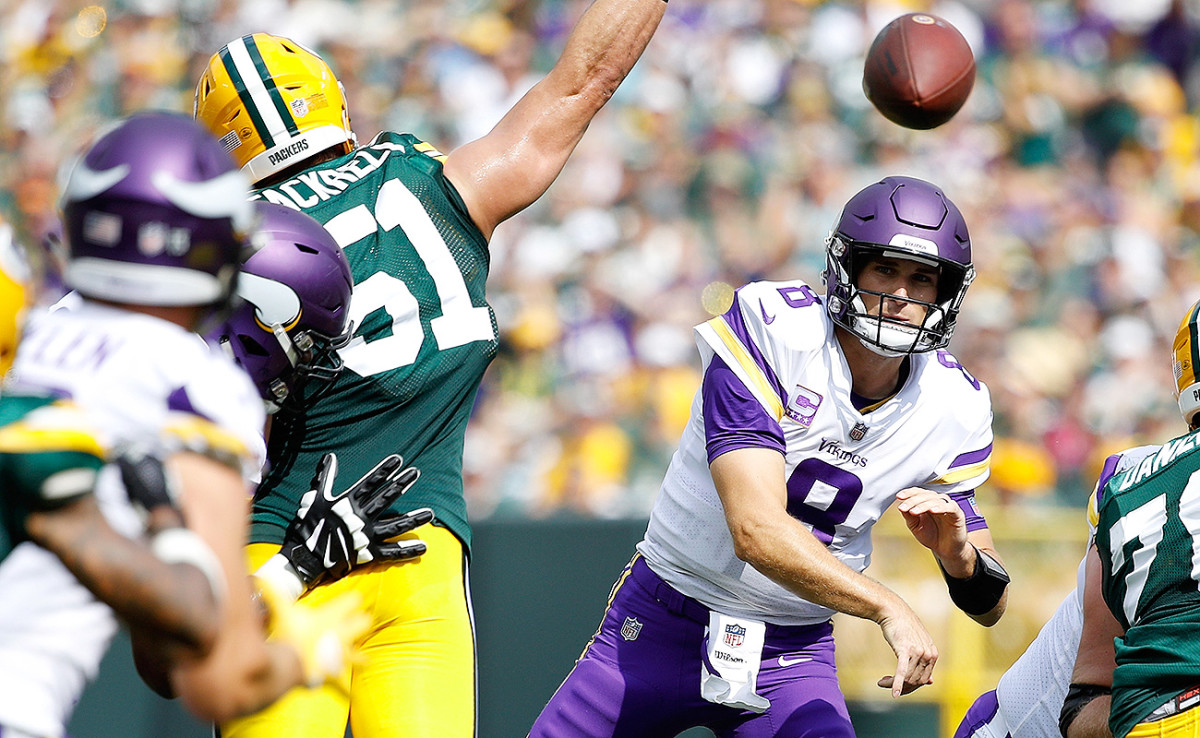
After carving up the 49ers in the season opener, Cousins and the Vikings travel to Green Bay in Week 2. They trail 20–7 at the start of the fourth quarter—but here comes the QB, slinging passes all over the field, looking precisely like the final piece. He throws for 425 yards and four TDs, lofting the tying (and the game’s final) score to Thielen between defenders as Cousins gets crushed. 29–29. “If the first two games haven’t put all the questions about Kirk to rest,” says Rudolph, “I don’t know what would. That’s why we brought him here, to bring consistency to that position.”
Later, Cousins and Thielen watch the replay on the team bus, laughing at how NFL games are won and lost (or tied) by the slimmest of margins. Thielen notes how his new QB throws a better deep ball than he’d expected. He’s tougher than advertised, too, fitting with how the Vikings see themselves—as one of football’s toughest teams.
Zimmer believes the Cousins he watched in August was “pressing” too hard, trying to live up to his deal. The guy on the field today, though, he says, is “everything we expected.”
Minnesota has the league’s sixth-youngest roster, so many players see Rudolph as an elder statesman even though he’s only 29. In his eight seasons, he has learned this: Never read too much into a fast or slow start. The 2012 Vikings started 6–6, but four straight wins at the end nudged them into the playoffs. Four years later they shot out to 5–0 but ended up 8–8 and missed the postseason.
VRENTAS: Drawing Inspiration: Desmond King and His Brother Devon Form a Powerful Bond Through Art
With his third child due on the same day that this year’s NFC Championship game is planned, in January, Rudolph wonders if he might stumble into a glorious scheduling conflict. After two weeks, he believes strongly it will happen. “For so many years, we’d go into a game and it’s like, God, we have to play perfect tomorrow and hope they don’t play so well to win,” he says. “That’s not the case anymore.”
Zimmer, for his part, is never sure this early in a campaign. That’s why he sleeps some nights in his office, pulling down the Murphy bed. But he hides any concern well. Griffen says Zimmer used to be “more uptight, more angry.” These days, sometimes, he even smiles. “He’ll slide a little joke in there when you’re not ready for it,” says safety Harrison Smith.
The coach is not happy, though, with a 1-0-1 record. In the space near the locker room where the team plasters photos from each win, he’ll later notice several snapshots from the Green Bay game and order them all taken down. Not for a tie.
Spielman shares some of these concerns, and while Zimmer speaks to players in Green Bay’s visitors’ locker room, the GM is already rejiggering his roster. The kicker he drafted in April, Daniel Carlson, missed three field goals, effectively costing Minnesota its second win, and he’s promptly cut. Arriving back in Minneapolis at 6:30 p.m., Spielman and Paton watch film and make phone calls almost until midnight, settling in the end on Dan Bailey, the second-most-accurate kicker in NFL history and a salary cap casualty in Dallas. The Vikings then sign wideout Aldrick Robinson, who played a few years with Cousins in Washington, and defensive tackle Tom Johnson, who was released by the Seahawks, for depth. Does all of this action signify any sort of win-now panic? Spielman only admits he’s never before reconfigured such a talented team like this after Week 2.
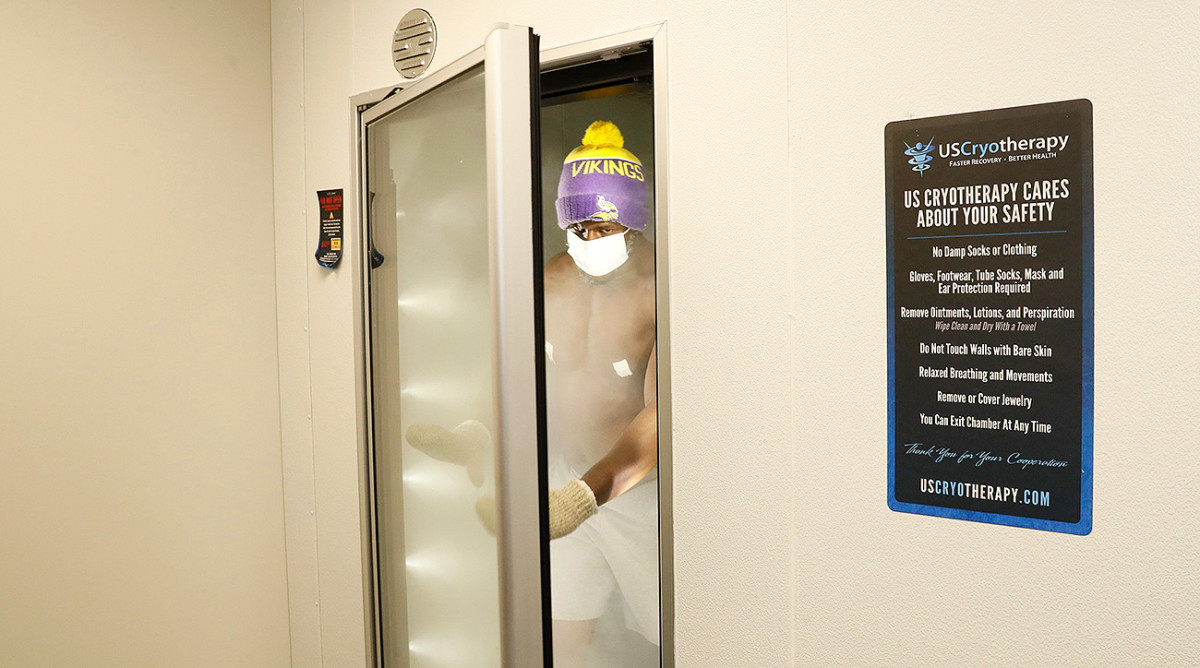
Two days before the Week 3 kickoff against the Bills, Cook lingers outside the Vikings’ cryotherapy chamber, a sort of super-charged walk-in freezer. Dressed in purple shorts, socks, slippers and earmuffs, he bounces up and down, blasting hip-hop and readying himself for the -180° temperatures. Inside, he paces for 150 seconds as icicles form on his eyebrows and his skin temperature drops 30 degrees. As he exits he laughs, hopeful the session will help heal the left hamstring he tweaked against the Packers.
It doesn’t work: Cook misses the Buffalo game, and in his absence the Vikings stumble badly. They get slammed at home by Josh Allen, a rookie QB making his first-ever road start. Mike Boone leads Minnesota in rushing with 11 yards. This is the first real sign there may be cracks in the Vikings’ season. Injuries are piling up, particularly on offense, where center Pat Elflein and guard Nick Easton are out. Because the Vikings aren’t healthy, they’re not balanced. And without that balance, a rift has started to develop between coordinator and coach, who wants Minnesota to run more often. It’s kept private, for now.
After the game Zimmer drives to the Eagan office and scours film until the early morning. He sees some things he likes about this team, which he has invested all of his life into, shedding pounds as the season moves along—the stress diet. He wants the tape to convince him that anything is still possible in late September, but what he sees on the screen concerns him. Specifically, his defense is a mess.
It doesn’t help that Griffen missed the Bills game following an incident at a hotel, where the three-time Pro Bowler allegedly threatened to shoot someone. (No arrest was made; no weapon was found.) Zimmer says he wants Griffen to tend to his mental wellbeing the same way he might nurse a leg injury, so he will be out indefinitely.
What a season, the coach thinks as the film plays. Tony Sparano, the Vikings’ O-line coach and a close friend from their days together in Dallas, died in July, of heart disease. Sparano would have turned 57 on Oct. 7. Zimmer recounts how he’d stop by Sparano’s office most mornings to talk strategy, two “straightforward and grumpy” guys (Zimmer’s words), “always negative, in a good way,” trying to figure out the next opponent.
When Zimmer’s wife died suddenly in 2009, Sparano checked in on his future boss regularly. Now it’s Zimmer looking after Sparano’s wife, Jeanette, texting to say, simply, “I miss Tony.”
Says Zimmer: “He’d be grumbling about the run game right now. That was his baby.”
It’s only Week 3. The coach digs in, resolute to find a fix.
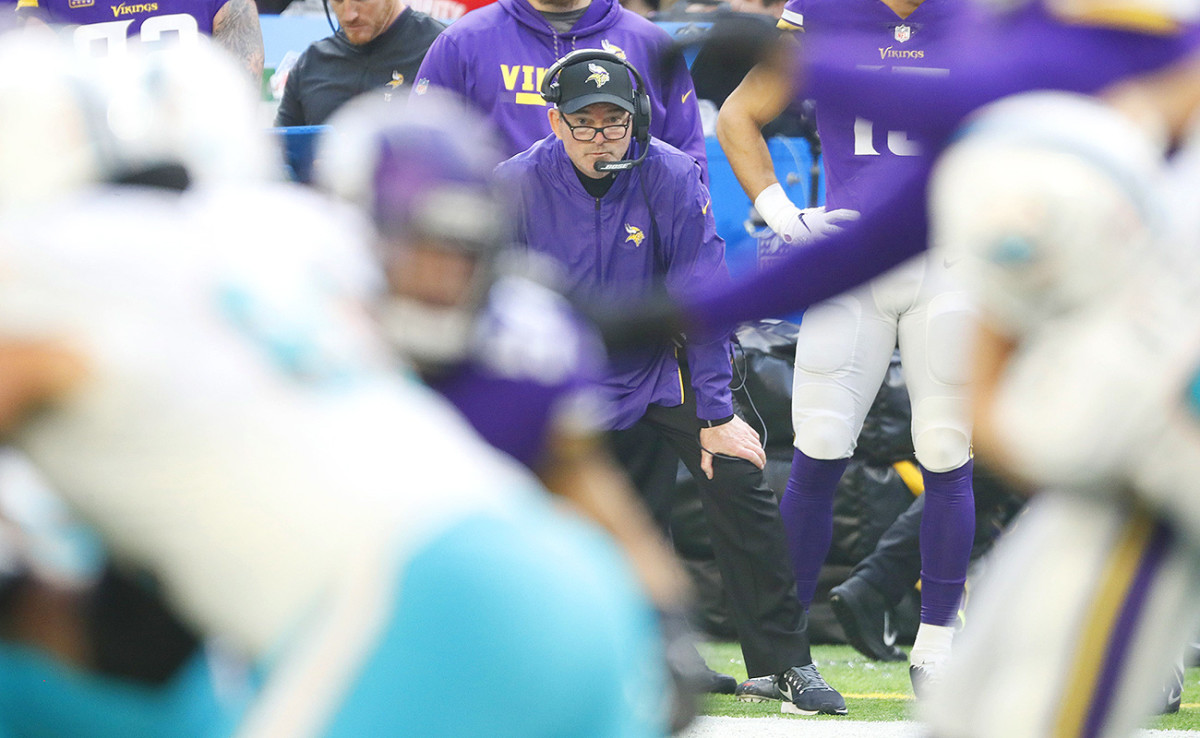
In the players’ lounge of the Vikings’ headquarters, in late September, next to the fireplace that’s never on, there’s a sign that reads THE ZIM REAPERS, a reference to the coach and his baby, a defense that’s usually one of the NFL’s most consistent and most feared. The unit finished atop the NFL in 2017. So what’s changed? Settled into a black leather couch, iPad in hand, Smith is deep into film study, trying to figure that out. He’s not exactly sure why the D hasn’t yet approached its usual standards, or how the Rams gashed the Vikings for 556 total yards in L.A.’s 38–31 Week 4 win.
He has some ideas, though—notions tied to league trends, like the historic and histrionic offensive start to the 2018 season. With rules changing, again, to aid offenses and with shifts in how referees call targeting, personal fouls and pass interference, defenses across the league are struggling to adapt. Zimmer’s Vikings traditionally play a lot of Cover 4, an aggressive match-up zone where four DBs are each responsible for a quarter of the deep part of the field. And the rule shifts seem to be hampering that aggression. Safety Andrew Sendejo is struggling to adapt, and opponents are attacking the Vikings’ linebackers in pass coverage.
Smith isn’t making excuses, though. The rules impact everyone, he says, pointing to one particularly egregious roughing-the-passer call on Packers linebacker Clay Matthews that benefitted the Vikings on the game-tying drive. He feels especially bad for the league’s hardest hitters, an endangered species in this NFL. And that’s the Vikings, too: old school, smashmouth—as if from an earlier era. It’s possible they’re impacted more than any team by these changes. Still, Smith knows they must adapt to save their season.
Zimmer knows, too. He’s emphasizing new rugby-style tackling techniques in practice and looking for ways to tweak his scheme, continuing the NFL’s perpetual chess match of adjustments.
The defense, though, isn’t the only issue. He’s not happy that Cousins led the Vikings in rushing against the Rams, with 28 yards. He’s certain Sparano is yelling at him from the grave. But he’s trying to be fair to DeFilippo, who’s working with a patchwork line that’s particularly weak inside. After years of investing early draft picks in their defense, the Vikings took Pittsburgh’s Brian O’Neill in the second round this year. Everyone seemed to agree the hulking right tackle was probably a year away from meaningful contributions. Instead, he’s their best lineman, which says a lot about the unit.
KAHLER: How It All Went Wrong in Packerland
Two speeches, both preceding a pivotal Week 5 game in Philadelphia:
First, Zimmer invites Jessie Diggins, a Minnesotan and one half of the first American cross-country skiing team ever to win gold at the Olympics, to address his players. Her race in Pyeongchang, the team sprint, ended with Diggins edging across the finish line just 0.19 seconds in front of the silver medalist. The theme of her talk, Finishing, also applies to the Vikings’ season. She tells the players she typically concentrates on 10 pushes at a time, then the next 10, and then the next 10, until she has covered some 30 kilometers. Her mentality never changes, she says. Even on the verge of blacking out, she pushes forward. The implication seems obvious: They can do the same.
Later, in the visiting locker room shortly before kickoff, Cousins feels the massive mitt of nose tackle Linval Joseph land on his right shoulder. Joseph had been impressed when the quarterback spoke to the team in August, referencing stonecutters and generals and world wars. “You take the call,” Joseph tells Cousins, meaning he wants the QB to speak to the team before the game starts. “This is your team.” Cousins’s address plays off of Diggins’s speech. They need to finish, put it all together, become the team they know they could be.
Inside his office, near stacked cases of Diet Coke and Red Bull, DeFilippo cues up film from the Week 5 Eagles game, a 23–21 Vikings win. He says it shows what his offense is capable of. Minnesota led 17–3 in the third quarter, and DeFilippo says he “smelled blood in the water.” Starting a drive at his own five-yard line he dialed up consecutive deep passes, one to Thielen on a play called “Dolphin,” and another, “Dragon,” to Diggs. A field goal capped the drive and a victory seemed all but sealed.
In the end Cousins threw for 301 yards and a score, and Thielen surpassed 100 yards receiving for a fifth straight week. With 11 games left, DeFilippo considers the possibility that his offense takes off from here. And Zimmer, too, gets that glimmer of hope from his defense. Joseph sparked a turning point when Philadelphia was driving late in the second quarter, the game tied 3–3. Defensive line coach Andre Patterson says he wanted to attack Philly’s right tackle, Lane Johnson, by “threatening his outside shoulder;” Johnson, in those situations, had a tendency to over-kick. And when he did, Stephen Weatherly sprinted outside, then shifted back in, with a clear path to quarterback Carson Wentz, who never saw the defensive end knock the ball loose.
Joseph bent his 6' 4", 329-pound frame and scooped up the rock, the former high school running back rumbling to the end zone at 18.2 miles an hour, finally miming a home run swing and blowing kisses to the crowd after he scored. Then he plopped down on the bench and pulled on sunglasses and an oxygen mask. That image went viral, minus the context: The oxygen tank wasn’t working, and he wore the shades because a recent surgery had left his eyes sensitive to light. In the end he was a meme who might have saved the Vikings’ season. Maybe.
Three days later, as Joseph turns 30, he thinks back to the beginning of his career, winning Super Bowl XLVI with the Giants when he was 23, and how he figured he’d be back every year. Instead he’s played three playoff games in seven subsequent seasons.
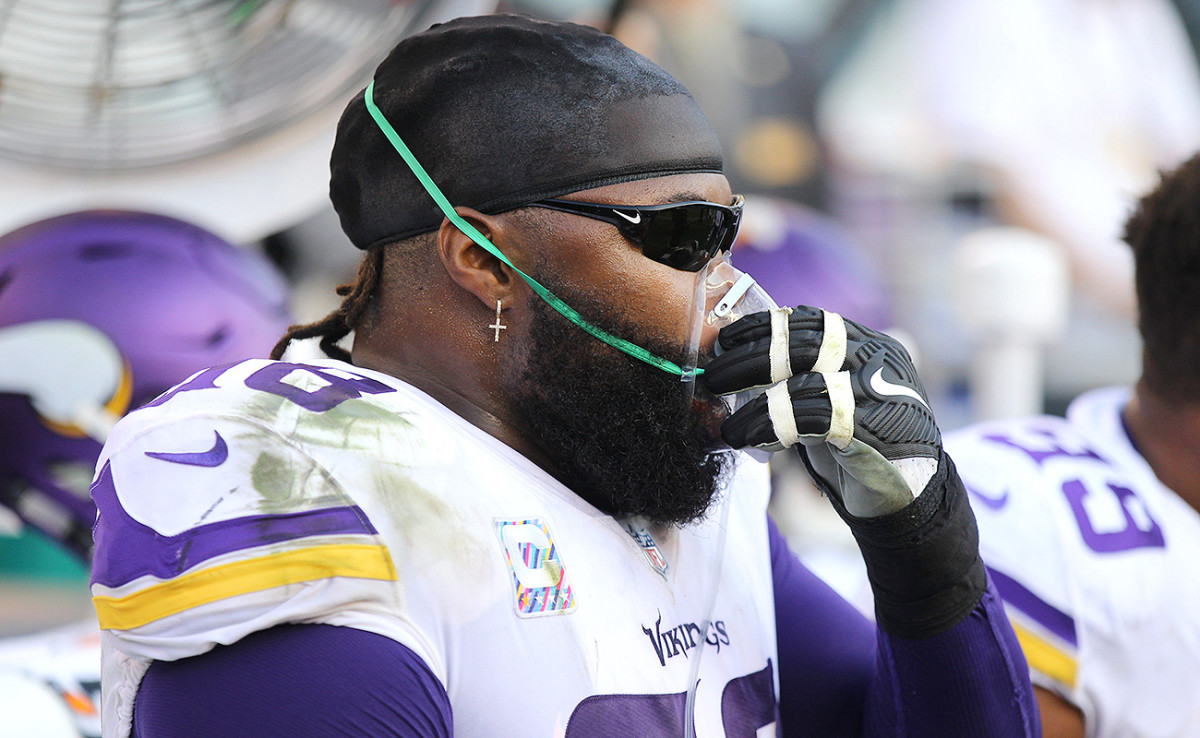
Sometimes life interrupts. Cousins’s maternal grandmother has passed away, so the quarterback charters a plane to attend the funeral in Iowa. He gives a eulogy in front of dozens of relatives, focusing on how 91-year-old Martha Woodard fought through multiple bouts of cancer, how she taught him to carry himself with class and dignity and hold himself to the highest standard—even when, say, a season teetered on the verge of collapse. “That trickled down to our entire family,” he tells the crowd.
Cousins jets back to Minnesota in time for his meetings that night, but not before inviting the pilot to the upcoming game against the Cardinals, offering a ticket in his private box.
Spielman follows the same routine before every Vikings home game, and this week against the Cardinals is no different. This is a how a general manager survives 13 NFL seasons, by tempering his anxiety and finding order in the chaos. He wakes up at 5 a.m. He takes his dogs for a walk, following the same route. He eats the same breakfast sandwich: fried egg, bacon and peanut butter on a wheat round. He shaves the left side of his face, then the right. He puts his shoes and socks on before his pants, leaves his house at the same time so he can arrive at the stadium at eight, follows the same route, stops at the same gas station, uses the same pump and makes sure always to end his purchase on a zero.
Then he takes his walk around the stadium. Today light snow falls as he trudges into the parking lot, nodding at security, wireless earbuds blasting Steely Dan. As he strolls under a highway overpass he brings up his family, the reason he does all this, and how one of his six kids (all adopted) had told him recently that he couldn’t tell her what to do. Why not? he’d asked. “You’re not the boss here,” she said. “Mom is. You’re just the boss at your work.”
The GM has devoted his whole adult life to the same goal, going back to his days as a Southern Illinois linebacker and his first NFL job as a Lions scout, in 1990. Now he’s spent the last 13 seasons at the same organization. His ringtone is a Viking horn. Nobody here wants to win a championship more. This year he feels ... close.
BISHOP: Drew Brees Is Hiding in Plain Sight
Cousins’s family gathers inside a Norseman suite at U.S. Bank Stadium for the second half against Arizona. When Kirk slings a third-quarter touchdown to Thielen, everyone jumps up, even the guest-pilot from the funeral, hugs and high-fives all around. Thielen goes over 100 yards receiving again and someone shouts “You like that?!” over the din as Cousins dances a particularly suburban-dad-like jig that is sure to spur more memes.
“[Kirk’s] going to get roasted,” says his brother, Kyle. He’s here with two friends—it’s their annual football trip, which they dubbed Crushing the Capital back when they started this jaunt in Washington, in 2012. They’ve done one of these expeditions every year since, dressing up in onesies or suits, always making a late-night taco run on the night of their arrival. And strange things always seem to happen at the games they pick. One year, Kirk replaced Robert Griffin III on Capital weekend; another year was the original “You like that?!” game. This year? “The dad dance,” Kyle laments.
Whatever works. The Vikings win easily, 27–17, improving their record to 3-2-1. In the locker room Cousins dedicates the win to his late grandmother, then he brings up the TD celebration. “Usually [the media] are the ones that make me look like a dork,” he tells the team, as Thielen and Diggs burst into laughter. “I kind of play to that.” More laughter. “I’m not a total dork.”
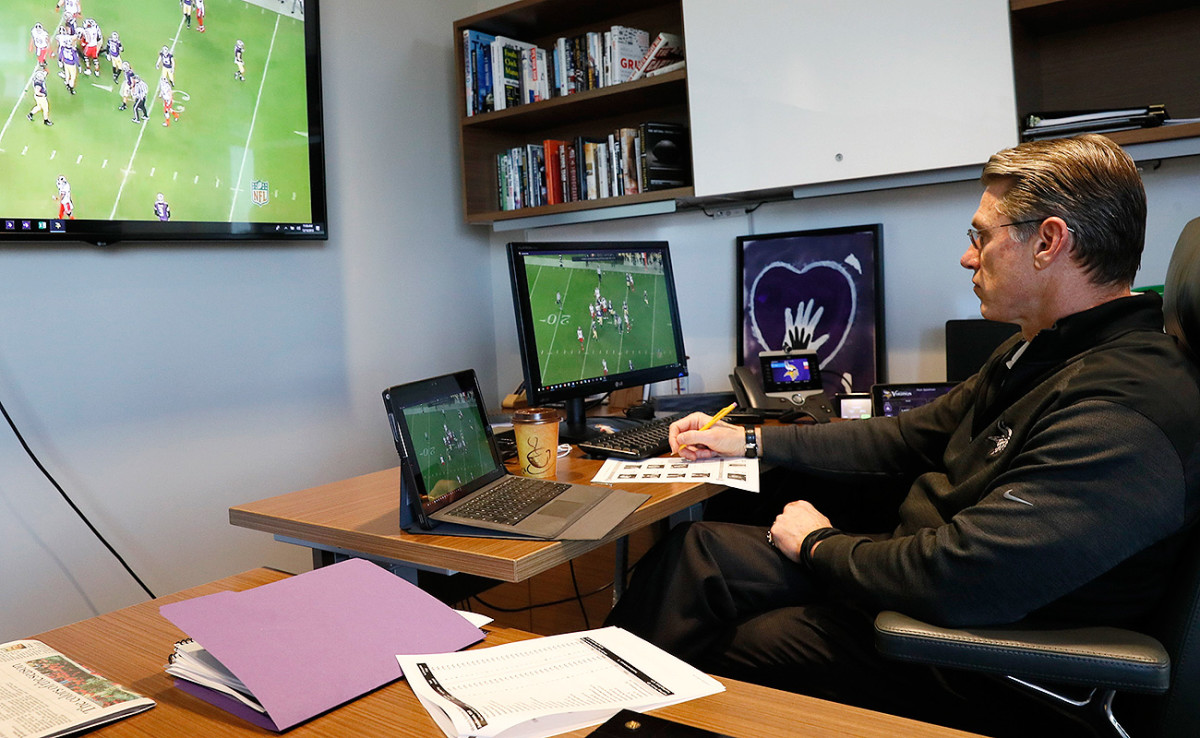
Thielen again passes the century mark in a Week 7 win over the Jets, and in a Week 8 loss to the Saints he ties Calvin Johnson’s NFL record of eight straight 100-yard games. Zimmer is impressed, but not totally showing it. “Let’s not put him in Canton yet,” he says, echoing his mentor, the equally crusty Bill Parcells.
The Vikings discovered Thielen in 2013 at one of the open tryouts they hold each season. They cared less that he’d played his college ball at D-II Minnesota State and more that he busted his ass on special teams and barked at DBs in practice. Spielman likes how the scrap heap receiver has come to represent his team’s philosophy. The GM collects players, even coaches, who out-perform their expectations, who stare down challenges and cackle. The leader, Zimmer, who coached through several eye surgeries in 2017. The franchise QB whose old team let him walk. The receiver who played his way in, one in a million, at a tryout.
Spielman has signed undrafted players like fullback C.J. Ham, wideout Chad Beebe, safety Anthony Harris and returnman Marcus Sherels because in some ways they remind him of Thielen. They live for special teams. They play whatever role is asked of them. As the calendar turns to November the Vikings are 4-3-1, with crucial contributions from these players. Minnesota will need help from everyone on the roster to remain in contention.
That includes the MIA defensive end. For weeks—especially since the D has allowed 24.4 points per game—speculation has swirled around Griffen’s absence. What happened at the hotel? Will he play again? Is he fit to, mentally? Inside the team’s bubble, though, only the last question matters; his health remains a top priority, team officials say. Questions are deflected and caution is taken not to jump to conclusions over an event about which details are scant.
The first time Patterson watched Griffen on film, after he became Minnesota’s D-line coach in 2014, he knew he had to coach him. Griffen, a former fourth-round pick, wasn’t yet a starter; he was a soon-to-be free agent who played mostly on special teams. But Patterson told Zimmer, “This is the most athletic guy you’ve got; I don’t know why he’s not playing,” and the Vikings re-signed him. Patterson texted Griffen that day: “If you listen to me, I promise you’ll be a Pro Bowler.”
Patterson taught Griffen how to leverage his hands, optimizing his raw explosiveness, and by Year 2 he was a Pro Bowler. He became, to Patterson, like a son. Which is what makes this year so hard: There is little Patterson can do to help. “I think about [Everson] every day,” he says. “I pray for him every night.”
Spielman, meanwhile, says he’s dealt with “four to five” situations like this over the course of his three-decade career. And he believes the paradigm is changing. “The stigma on mental illness, and how if you’re a professional athlete that’s a sign of weakness”—that, he says, is evolving. “It shouldn’t be like that.”
Instead, the team has worked with Griffen on a treatment plan, a combination of resources already available to him (or anyone else), plus whatever time he needs away. One on-site clinician maintains contact with the league office and its support services, and a second specializes in behavioral and addiction counseling. There’s a mental performance consultant, plus relationships with local psychologists and psychiatrists, and counseling plans. “The beauty,” says Patterson, “is that . . . he’ll be a tremendous advocate for the cause.”
VRENTAS: Everson Griffen Is on His Teammates’ Minds
In building his defensive line Patterson has leaned on the lessons he learned at Weber State, where he coached alongside Zimmer in 1988, making do with two-star players since they weren’t signing top prospects. Back then he and Zimmer started to identify the skill sets they wanted for each position. For D-linemen they sought long, athletic players, high school tight ends they could mold into something more. All these years later, they stick so closely to the original blueprint that Spielman says, watching the D-line practice, they all “almost look identical, like clones, like they’re all power forwards on a basketball team.”
Patterson loved Griffen’s defensive bookend, Danielle Hunter, from the moment Hunter’s high school coach declared he “could be the best tight end in the league.” The Vikings assistant eventually sent Hunter the same text message he sent Griffen. And again he was right. One of the best defensive ends in pro football, Hunter has eight sacks in the Vikings’ first seven games this season.
The Vikings molded their defensive line into a strength. They signed Joseph from the Giants in 2014 and Patterson focused on the import’s technique, complementing his natural, brute strength. Now, Patterson says Joseph is “the best three-technique in the league” and one of the best athletes on Minnesota’s roster, period.
The most important piece relative to this season might have been Weatherly, a seventh-rounder who played linebacker at Vanderbilt, majored in sociology, learned to play nine instruments and speak four languages, traveled throughout Germany in high school and solved Rubik’s Cubes for fun. He, too, is Patterson’s guy, more or less, and he starts—and thrives—in Griffen’s absence.
When Griffen reclaims his spot, before the Saints game in late October, neither he nor the team address in any detail the hotel incident or the treatment he received in his month away—but the D-line finally starts to look like itself again. Even then, Zimmer is adapting, tweaking his scheme, dropping more defenders into coverage because he can get pressure from his full-strength front. He also appears to play more Cover 3 than Cover 4 and limits his double-A-gap blitzes, tweaking his tendencies before opponents can exploit them. Against the Lions, in Week 9, the Vikings bag a franchise-record 10 sacks, 1 1/2 of them by Griffen.
The defense is no longer the problem. Cook remains sidelined. Cousins is fumbling—three times against Buffalo and once more in each of the next four games—enough to raise concerns. As the Vikings limp into their Week 10 bye at 5-3-1, Zimmer still has work to do.
“Coach and I get along very well,” says DeFilippo, the man whose unit has lost its early explosiveness. “We’re both very blunt people. But if there’s something he wants to tell me, he tells me.”
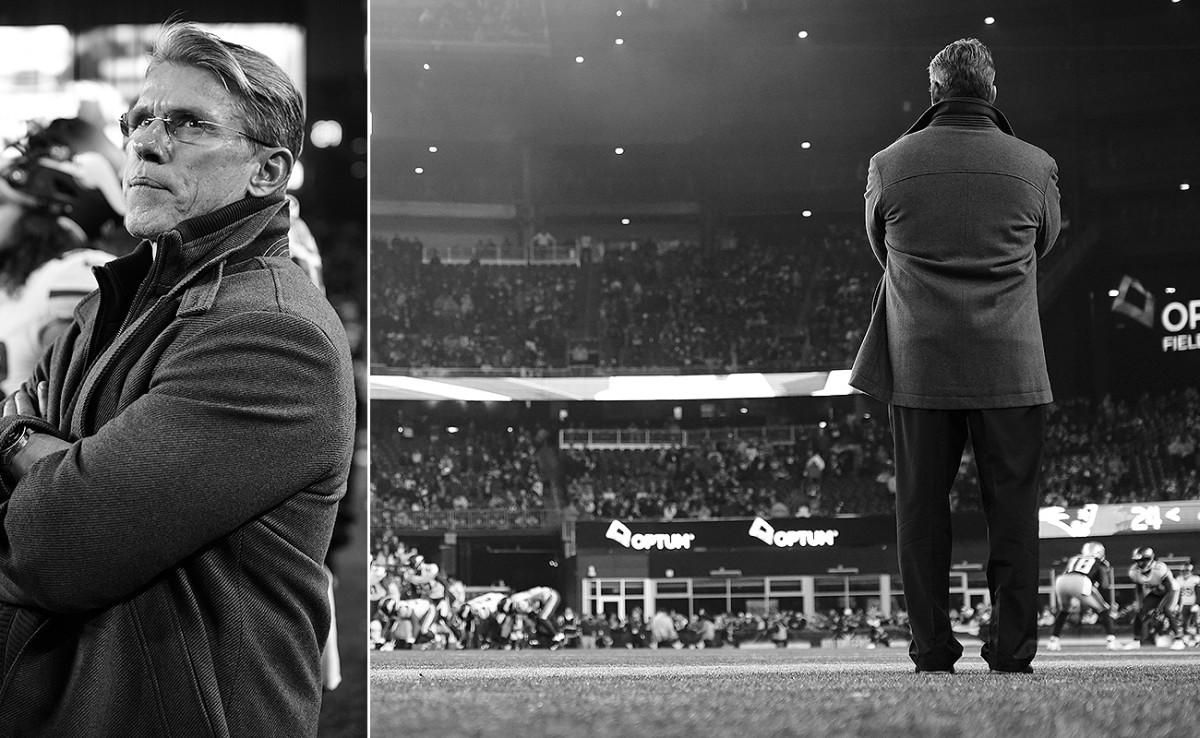
The Vikings’ post-bye schedule: at Chicago, against Green Bay, then at New England and Seattle. They can seize control of the division if things go well. They do not.
Even after Minnesota falls to the Patriots, Spielman lauds this season as “maybe [Zimmer’s] best-ever coaching job,” given the need to mesh together a new quarterback, a new coordinator and a new offense while dealing with all the missing players. But the Vikings still lose three of four, against likely playoff teams that expose their flaws, which can no longer be pinned on Zimmer’s rebounding defense.
As the season starts to spiral, the focus of Minnesota’s issues lands largely on DeFilippo, who has called for runs an average of just 21 times per game through Week 13, fourth-fewest in the league. Dozens of columns and hundreds of TV hours are devoted to the lack of a ground game. Reality isn’t that simple, though. A healthy Cook would have helped the balance, and not just in the sense of total runs versus total passes. The Vikings, Cousins says, need to hit on more “lay-ups,” or low-risk, high-reward plays, like short dumps to the running back in the flat, to put them in better positions on second or third down.
On the eve of the Seattle game in Week 14, the QB looks at the stakes and reflects on his free-agency move: “I don’t think there’s any doubt this was the right decision for our family. The onus is on me, on us, to deliver, to win.”
KLEMKO: Where Patrick Mahomes Gets His Cool
DeFilippo closes the shades in his office and evaluates all of this on film. There’s a growing criticism of his QB, painting Cousins as uneven, but the O.C. calls this unfair. Cousins’s presence has swung more games Minnesota’s way than it has the other way. But it’s hard to find the same show of support for DeFilippo. Week after week Zimmer attacks his run calls publicly, and then sometimes again internally, in front of the offense right before the O.C. addresses them.
DeFilippo looks at his unit through 12 games and grades the offense as excellent in five, efficient in four and “the pits” in the other three. In a nutshell, inconsistent. As in: 37 points against the Jets, and six against the Bills. But that doesn’t all boil down to just scheme. The offense lacks depth on the line and at receiver beyond Thielen and Diggs.
Cousins concurs with the ratings, at least. “If you look at the top offenses,” he says, “they’re going to say 90% of their games are the explosive kind. They’re opening up and scoring over 30 points and being dynamic.
“We’ve just gotta get there.”
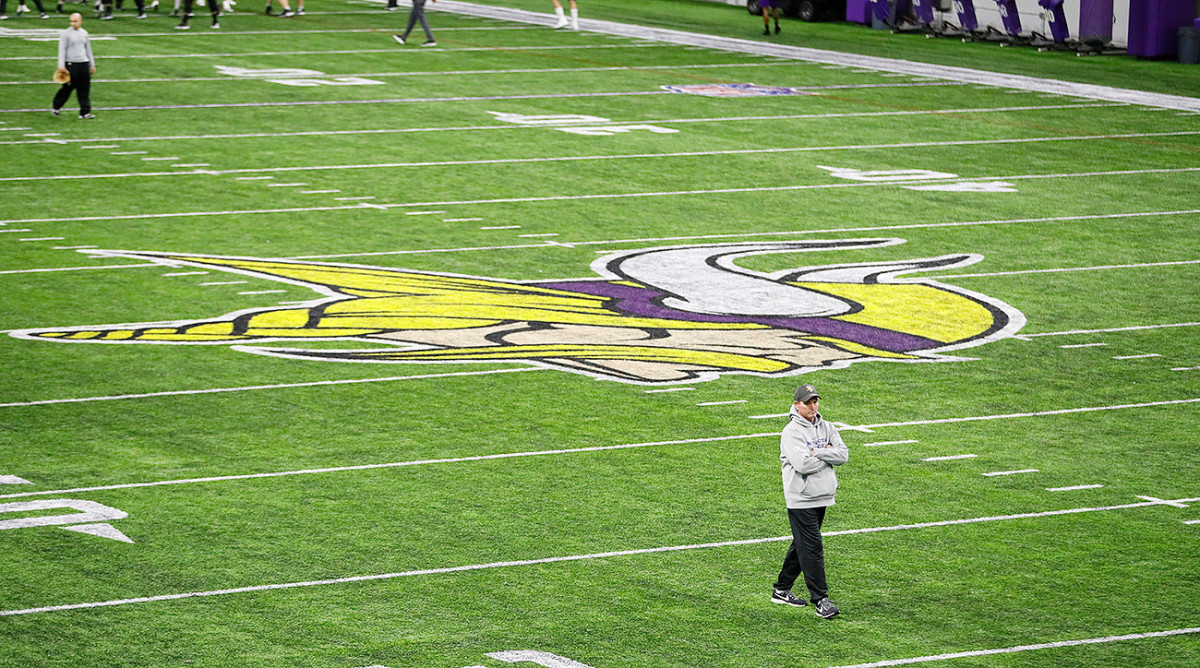
On Dec. 5, a scheduled off day, Zimmer calls his team in for an 11 a.m. meeting. He wants to stress everything that will be at stake in their Monday night game in Seattle. He again calls out his offensive coordinator, again stresses how he wants to rush the ball more, one week after DeFilippo called just 13 run plays. He tells everyone to forget the seesawing of the season so far, to view the final four games as the start of their playoffs. He tells the players they are welcome to stand up and say anything they want.
Smith, the veteran safety, steps forward, looks around the room and tells his teammates they’ve lost some of the “nasty” mentality that once distinguished them. They’ve made the game too complicated. Scheme, practice, strategy—all of that is important, but victory sometimes comes from physical imposition, from taking another man’s will. “We play the best when we play willing to lose,” he says.
Cousins goes next, rooting his remarks in simple math. Should the Vikings win out, he says, they’d likely take the NFC North. Go 3–1 and we should make the playoffs. Go 2–2, though, and we don’t deserve an extra game. He promises he will play his best football.
Three days later the Vikings land in Seattle, where players alleviate their anxieties by toggling between game film and Netflix. Spielman walks 6.2 miles downtown, burning off nervous energy. And on Sunday the team rides four buses in silence behind a police escort to a final practice at the University of Washington. Cook, who’s been easing his way back into DeFilippo’s game plan, spends the 15-minute ride on his phone, telling a friend, “Let’s see what we do!”
He will not like the answers, though. The Seahawks dominate the line of scrimmage, bottling up Cook (13 rushes, 55 yards) and turnstiling the Vikings’ offensive line. Thielen, double-teamed often, doesn’t catch a pass until midway through the third quarter; after his streak ended in Week 9, he’s topped 100 yards just once in five games. Cousins botches a potential go-ahead touchdown throw; his personal record on Monday Night Football drops to 0–7. When Seattle blocks a field-goal attempt, it’s a harsh knife-twist for Vikings fans, who’ve witnessed a lifetime of kicking woes.
Late in the game Thielen, Mr. Minnesota, is caught on camera muttering complaints about the play calls. He’s not alone in his disgust. DeFilippo will fly home with the team, return to his office, analyze film ... and then be fired, at 10:30 a.m. on Tuesday. Zimmer hands the offense to quarterbacks coach Kevin Stefanski, his new coordinator.
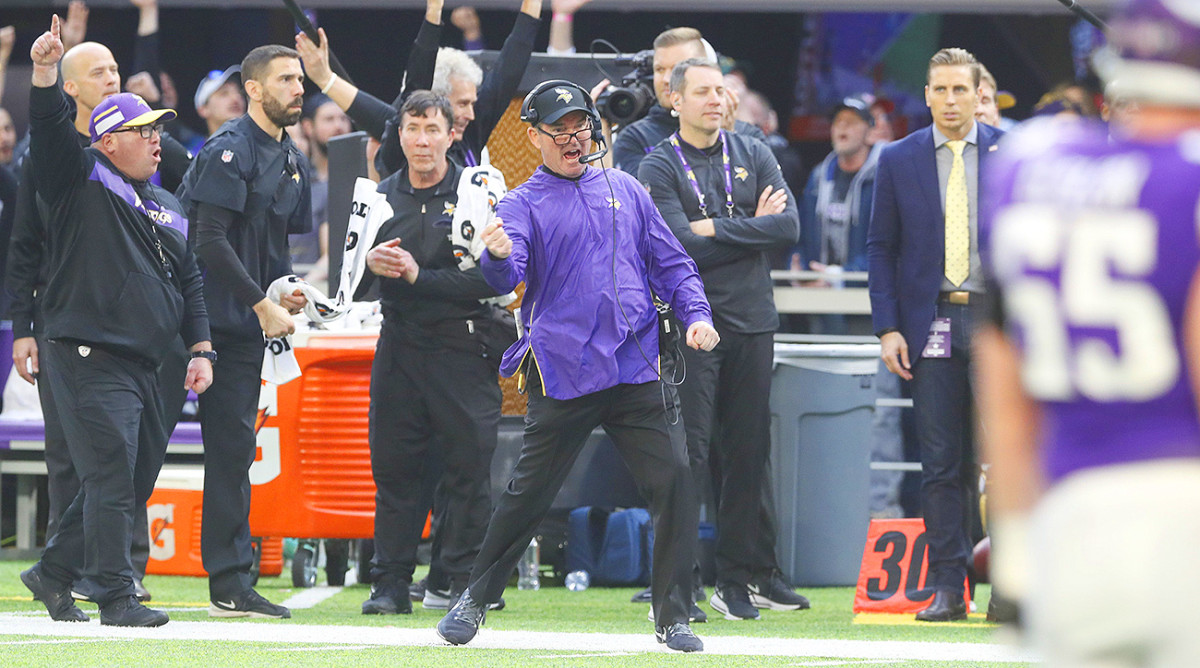
Was that the end? That’s not how the EKG works. In keeping with the season’s theme, the Vikings gash the Dolphins for 41 points in Week 15, their highest output in three years. They rack up 220 yards on the ground, a season high, while a healthy Cook goes off for a career-best 136. And the defense sacks Ryan Tannehill nine times, marking just the second instance since 1990 of a team hitting at least that number twice in the same season. A week later they pour 27 points on the Lions, limiting Detroit to 86 rushing yards and holding Matthew Stafford to an abysmal 116 passing yards, which gets him benched.
This is life in the NFL, an unstable week-to-week existence defined as much by what happens between games as by what happens on the field, as much by the obvious (the facility, the free-agents signings) as by more inconspicuous events (injuries, unexpected absences, funerals, coaching rifts...). The Vikings’ key contributors have missed 75 combined games to this point, and yet here they are. Thielen, Smith, Hunter and linebacker Anthony Barr are named Pro Bowlers. Griffen wins the team’s Ed Block Courage Award, which is voted on by teammates. Together, they’re in position to make the playoffs heading into Week 17, a scary high-ceiling team sneaking up on the plateauing Saints and Rams.
“Seasons are that way,” says Alan Page, the Hall of Fame Vikings defensive lineman. “That’s the oblong spheroid. It can bounce in funny ways. Always has.”
Page says this from the in-house television studio at the practice facility in Eagan, an amenity he never could have imagined when he began playing in the ’60s. This season, meanwhile, moves forward. Always does. The Vikings will make the playoffs if they win Sunday against the Bears. Win out through the postseason and they obtain everything they’d hoped for, that final and most elusive goal. For this franchise with a tortured history, it’s all there for the taking in this up-and-down season. Maybe Spielman and Zimmer and Cousins get where they intended, just on an unexpected path.
“Eventually they’ll win the Super Bowl,” says Page. “When? We don’t know. Eventually.”
Additional reporting by Andy Benoit.
Question or comment? Email us at talkback@themmqb.com.
